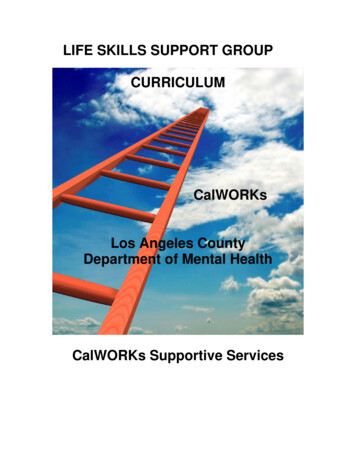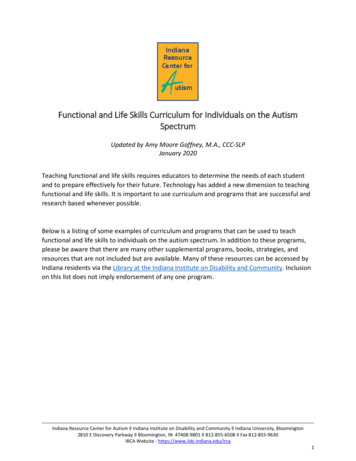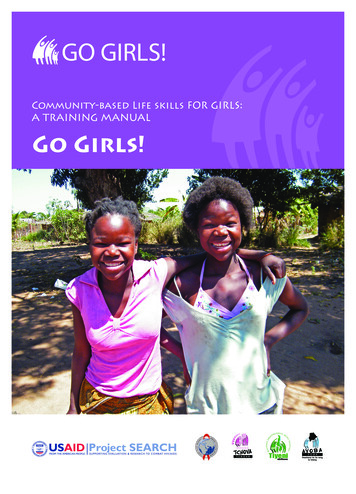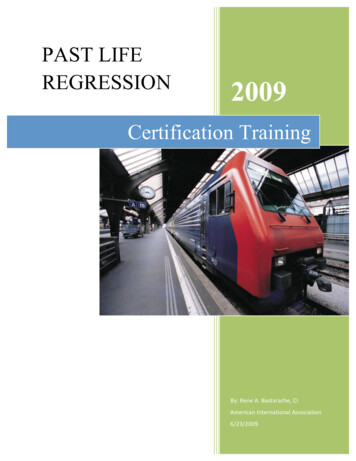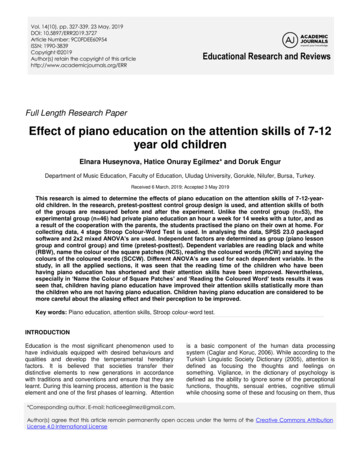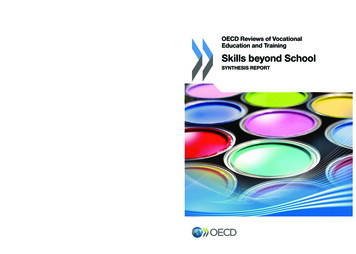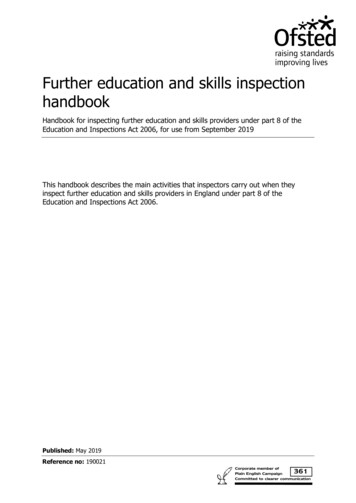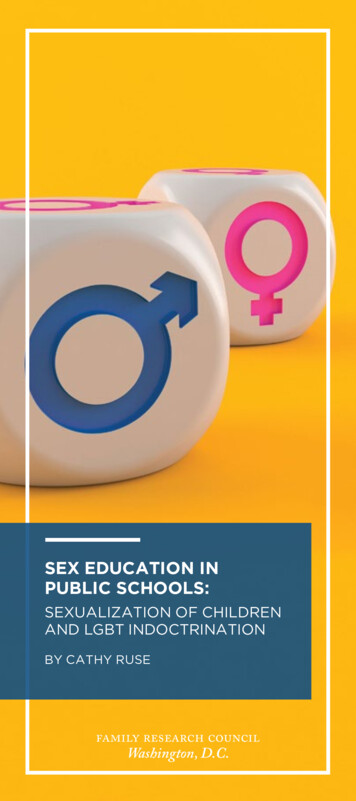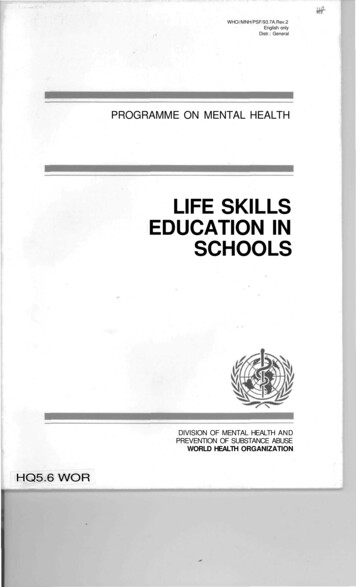
Transcription
WHO//MNH/PSF/93.7A.Rev.2English onlyDistr.: GeneralPROGRAMME ON MENTAL HEALTHLIFE SKILLSEDUCATION INSCHOOLSDIVISION OF MENTAL HEALTH ANDPREVENTION OF SUBSTANCE ABUSEWORLD HEALTH ORGANIZATIONHQ5.6 WOR
WHO/MNH/PSF/93.7A.Rev.2English onlyDistr. General2806623131LIFE SKILLS EDUCATIONFOR CHILDREN AND ADOLESCENTSIN SCHOOLSIntroduction and Guidelines to Facilitate the Developmentand Implementation of Life Skills ProgrammesThis document was compiled in 1993 to assist with the further development of life skillseducation. It has been in great demand since that time, and since it is now being reprinted, theopportunity has been taken to make a few small changes. It should be emphasized however, that thedocument has not been changed In any substantial way. Its purpose Is to outline a framework for lifeskills programme development, both conceptually and practically. The materials focus on the teachingof life skills to children and adolescents in schools. This document is therefore targeted at those agenciesInvolved In school curriculum development, health education, and the development of school-basedhealth and social interventions. Life skills education is relevant to everyone and the contents of thisdocument, although directed at schools, can be adapted and interpreted to guide the developmentof life skills education for children that are not in schools, as well as for adult education and as part ofcommunity development projects.The two parts contained in this document (Part 1, Introduction to Life Skills for PsychosocialCompetence and Part 2, Guidelines: The Development and Implementation of Life Skills Programmes)may be used in conjunction with another document (WHO/MNH/PSF/93.7B.Rev. 1) Training Workshops forthe Development and Implementation of Life Skills Education by those who are involved In the settingup of programmes. It should be emphasized that the material in these training workshops Is not relatedto classroom activities and is not intended to help individual teachers who may wish to introduce life skillseducation into their own teaching programmes; it is primarily to assist the training of those people whowill be involved In the development and Implementation of life skills programmes at national orsubnational level.This document is being circulated as part of the life skills project of the Programme on MentalHealth, WHO, Geneva. The Newsletter 'Skills for Life' is also available. This describes life skills initiativesaround the world, as well as the work of WHO and other UN agencies in the support and promotion oflife skills education. For more information contact The Life Skills Education Project, The Programme onMental Health, World Health Organization, 1211 Geneva 27, Switzerland.MPROGRAMME ON MENTAL HEALTHWORLD HEALTH ORGANIZATIONGENEVA1997
ACKNOWLEDGEMENTSThe following people contributed to the development of this document.Rhona Birrell Weisen, WHO, GenevaJohn Orley, WHO, GenevaVivienne Evans, TACADE, UKJeff Lee, TACADE, UKBen Sprunger, Life Skills International, USADaniel Pellaux, Mandat Plus Prevention, SwitzerlandThe following people are acknowledged for their support and guidance.Jane Ferguson, WHO, GenevaJack T. Jones, WHO, GenevaUNICEFG.O. Adetula, National Drug Law EnforcementAgency, Lagos, NigeriaLeonardo Mantilla Castellanos, Ministry ofHealth, Santafe de Bogota, ColombiaElena Nightingale, Carnegie Corporation of NewYork, USAJulian Oliver, UK Drug Demand ReductionTask Force, London, UKRuby Takanashi, Carnegie Corporation of NewYork, USAUte Deseniss-Gros, Programme Communication/Social Mobilization Section, New YorkBruce Dick, Youth Health Promotion, New YorkRegina Faul-Doyle, Health Cluster, New YorkAnthony Hewett, Programme Communication/Social Mobilization Section, New YorkLakshman Wickramasinghe, CommunicationOfficer, UgandaMohammed Jalloh, Communication Officer,Sierra LeoneFinancial support for the development of these materials has been provided to WHO bythe J o h a n n J a c o b s Foundation, Zurich, Switzerland and the CarnegieCorporation of New York, USA. The Trainer's Guide and Workshops, available asa separate document were prepared by TACADE, UK with a grant from the UK DrugD e m a n d Reduction Task Force.Further copies of this document may be obtained fromProgramme on Mental HealthWorld Health Organization1211 Geneva 27Switzerland World Health Organization 1994This document is not a formal publication of the World Health Organization (WHO),and all rights are reserved by the Organization. The document may, however, be freely reviewed,abstracted, reproduced or translated, in part or in whole, but not for sale or for use in conjunction withcommercial purposes.The views expressed in documents by named authors are solely the responsibility of those authors.
CONTENTSPagePart 1Introduction to Life Skills for Psychosocial Competence 1Part 2Guidelines: The Development and Implementation of Life SkillsProgrammesDeveloping a life skills support infrastructureFormulating objectives and a strategy for life skills programme developmentDesigning life skills programme materialsTraining of life skills trainersPilot testing/evaluating a life skills programme and trainingImplementing a life skills programmeMaintenance of a life skills programmeAppendix:99131925293335Sample Life Skills Lessons and Life Skills Programme LessonTitles a n d Sequence37Sample Life Skills LessonsLife Skills Programme Lesson Titles and Sequence3947
WHO/MNH/PSF/93.7A.Rev.2Page 1PART ONEINTRODUCTION TO LIFE SKILLS FOR PSYCHOSOCIAL COMPETENCEPromoting Psychosocial CompetencePsychosocial competence is a person's ability to deal effectively with the demands andchallenges of everyday life. It is a person's ability to maintain a state of mental well-beingand to demonstrate this in adaptive and positive behaviour while interacting with others,his/her culture and environment.Psychosocial competence has an important role to play in the promotion of health inits broadest sense; in terms of physical, mental and social well-being. In particular, wherehealth problems are related to behaviour, and where the behaviour is related to an inabilityto deal effectively with stresses and pressures in life, the enhancement of psychosocialcompetence could make an important contribution. This is especially important for healthpromotion at a time when behaviour is more and more implicated as the source of healthproblems.The most direct interventions for the promotion of psychosocial competence are thosewhich enhance the person's coping resources, and personal and social competencies. Inschool-based programmes for children and adolescents, this can be done by the teaching oflife skills in a supportive learning environment.Defining Life SkillsLife skills are abilities for adaptive and positive behaviour, that enable individuals todeal effectively with the demands and challenges of everyday life.Described in this way, skills that can be said to be life skills are innumerable, and thenature and definition of life skills are likely to differ across cultures and settings. However,analysis of the life skills field suggests that there is a core set of skills that are at the heartof skills-based initiatives for the promotion of the health and well-being of children andadolescents. These are listed below: Decision makingProblem solvingCreative thinkingCritical thinkingEffective communicationInterpersonal relationship skillsSelf-awarenessEmpathyCoping with emotionsCoping with stress
WHO/MNH/PSF/93.7A.Rev.2Page 2Decision making helps us to deal constructively with decisions about our lives. Thiscan have consequences for health if young people actively make decisions about their actionsin relation to health by assessing the different options, and what effects different decisionsmay have.Similarly, problem solving enables us to deal constructively with problems in ourlives. Significant problems that are left unresolved can cause mental stress and give rise toaccompanying physical strain.Creative thinking contributes to both decision making and problem solving byenabling us to explore the available alternatives and various consequences of our actions ornon-action. It helps us to look beyond our direct experience, and even if no problem isidentified, or no decision is to be made, creative thinking can help us to respond adaptivelyand with flexibility to the situations of our daily lives.Critical thinking is an ability to analyse information and experiences in an objectivemanner. Critical thinking can contribute to health by helping us to recognise and assess thefactors that influence attitudes and behaviour, such as values, peer pressure, and the media.Effective communication means that we are able to express ourselves, both verballyand non-verbally, in ways that are appropriate to our cultures and situations. This meansbeing able to express opinions and desires, but also needs and fears. And it may mean beingable to ask for advice and help in a time of need.Interpersonal relationship skills help us to relate in positive ways with the peoplewe interact with. This may mean being able to make and keep friendly relationships, whichcan be of great importance to our mental and social well-being. It may mean keeping goodrelations with family members, which are an important source of social support. It may alsomean being able to end relationships constructively.Self-awareness includes our recognition of ourselves, of our character, of our strengthsand weaknesses, desires and dislikes. Developing self-awareness can help us to recognisewhen we are stressed or feel under pressure. It is also often a prerequisite for effectivecommunication and interpersonal relations, as well as for developing empathy for others.Empathy is the ability to imagine what life is like for another person, even in asituation that we may not be familiar with. Empathy can help us to understand and acceptothers who may be very different from ourselves, which can improve social interactions, forexample, in situations of ethnic or cultural diversity. Empathy can also help to encouragenurturing behaviour towards people in need of care and assistance, or tolerance, as is the casewith AIDS sufferers, or people with mental disorders, who may be stigmatized and ostracizedby the very people they depend upon for support.
WHO/MNH/PSF/93.7A.Rev.2Page 3Coping with emotions involves recognising emotions in ourselves and others, beingaware of how emotions influence behaviour, and being able to respond to emotionsappropriately. Intense emotions, like anger or sorrow can have negative effects on our healthif we do not react appropriately.Coping with stress is about recognising the sources of stress in our lives, recognisinghow this affects us, and acting in ways that help to control our levels of stress. This maymean that we take action to reduce the sources of stress, for example, by making changes toour physical environment or lifestyle. Or it may mean learning how to relax, so that tensionscreated by unavoidable stress do not give rise to health problems.The life skills described above are dealt with here in so far as they can be taught toyoung people as abilities that they can acquire through learning and practice. For example,problem solving, as a skill, can be described as a series of steps to go through, such as: 1)define the problem; 2) think of all the different kinds of solutions to the problem; 3) weighup the advantages and disadvantages of each; 4) chose the most appropriate solution and planhow to realise it. Examples of lessons designed to facilitate life skills acquisition are includedin the appendix to this document.Inevitably, cultural and social factors will determine the exact nature of life skills. Forexample, eye contact may be encouraged in boys for effective communication, but not forgirls in some societies, so gender issues will arise in identifying the nature of life skills forpsychosocial competence. The exact content of life skills education must therefore bedetermined at the country level, or in a more local context. However, described in generalterms, life skills are being taught in such a wide variety of countries that they appear to haverelevance across cultures.Conceptualizing the role of life skills in health promotion Complementary life skills can be paired to reveal 5 main life skills "areas", as shownbelow. For health promotion, teaching skills in each of these areas provides a foundationin generic life skills for psychosocial competence.decision making problem solvingcreative thinking critical thinkingcommunication interpersonalrelationshipsself-awareness empathycoping with emotionsstressors The teaching of life skills appears in a wide variety of educational programmes withdemonstrable effectiveness, including programmes for the prevention of substance abuse(Botvin et al., 1980, 1984; Pentz, 1983) and adolescent pregnancy (Zabin et al., 1986;Schinke, 1984), the promotion of intelligence (Gonzalez, 1990), and the prevention of bullying(Olweus, 1990). Educational programmes teaching these skills have also been developed forthe prevention of AIDS (WHO/GPA, 1994; Scripture Union, undated), for peace education
WHO/MNH/PSF/93.7A.Rev.2Page 4(Prutzman et al., 1988), and for the promotion of self-confidence and self-esteem (TACADE,1990). Teaching life skills in this wide range of promotion and prevention programmesdemonstrates the common value of life skills for health promotion, beyond their value withinany specific programme. Teaching life skills as generic skills in relation to everyday life could form thefoundation of life skills education for the promotion of mental well-being, and healthyinteraction and behaviour. More problem specific skills, such as assertively dealing with peerpressures to use drugs, to have unprotected sex, or to become involved in vandalism, couldbe built on this foundation. There are research indications that teaching skills in this way,as part of broad-based life skills programmes, is an effective approach for primary preventioneducation (Errecart et al., 1991; Perry and Kelder, 1992; Caplan et al., 1992). The model below shows the place of life skills as a link between motivating factorsof knowledge, attitudes and values, and positive health behaviour; and in this waycontributing to the primary prevention of health problems.knowledgeattitudesvalues life skills(for psychosocial competence)behaviourreinforcement orchange— positivehealthbehaviour— preventionof healthproblems Life skills enable individuals to translate knowledge, attitudes and values into actualabilities - ie. "what to do and how to do it". Life skills are abilities that enable individualsto behave in healthy ways, given the desire to do so and given the scope and opportunity todo so. They are not a panacea; "how to do" abilities are not the only factors that affectbehaviour. If the model above was placed within a larger, more comprehensive framework,there would be many factors that relate to the motivation and ability to behave in positiveways to prevent health problems. These factors include such things as social support, culturaland environment factors. Effective acquisition and application of life skills can influence the way we feel aboutourselves and others, and equally will influence the way we are perceived by others. Lifeskills contribute to our perceptions of self-efficacy, self-confidence and self-esteem. Life skillstherefore play an important role in the promotion of mental well-being. The promotion ofmental well-being contributes to our motivation to look after ourselves and others, theprevention of mental disorders, and the prevention of health and behaviour problems.
WHO/MNH/PSF/93.7A.Rev.2Page 5Promoting the teaching of life skillsIn promoting the teaching of life skills, the WHO is promoting the teaching of abilitiesthat are often taken for granted. However, there is growing recognition that with changes inmany cultures and lifestyles, many young people are not sufficiently equipped with life skillsto help them deal with the increased demands and stresses they experience. They seem tolack the support required to acquire and reinforce life skills. It may be that traditionalmechanisms for passing on life skills (e.g. family and cultural factors) are no longer adequateconsidering the influences that shape young people's development. These include mediainfluence and the effects of growing up in situations of cultural and ethnic diversity. Alsothe rapid rate of social change, witnessed in many countries, makes the lives of young people,their expectations, values, and opportunities very different from that of their parents.Life skills for psychosocial competence need to be distinguished from other importantskills that we hope young people will acquire as they grow up, such as reading, numeracy,technical and practical "livelihood" skills. These and other skills are usually recognised asabilities that young people should learn, either in schools, at home or in their communities.Life skills are being promoted so that they can gain recognition as essential skills that shouldbe included in the education of young people.Life Skills EducationFor health promotion, life skills education is based on the teaching of generic lifeskills and includes the practice of skills in relation to major health and social problems. Lifeskills lessons should be combined with health information, and may also be combined withother approaches, such as programmes designed to effect changes in environmental and socialfactors which influence the health and development of young people.The methods used in the teaching of life skills builds upon what is known of howyoung people learn from their own experiences and from the people around them, fromobserving how others behave and what consequences arise from behaviour. This is describedin the Social Learning Theory developed by Bandura (1977). In Social Learning Theory,learning is considered to be an active acquisition, processing and structuring of experiences.In life skills education, children are actively involved in a dynamic teaching andlearning process. The methods used to facilitate this active involvement include working insmall groups and pairs, brainstorming, role play, games and debates. A life skills lesson maystart with a teacher exploring with the students what their ideas or knowledge are about aparticular situation in which a life skill can be used. The children may be asked to discussthe issues raised in more detail in small groups or with a partner. They may then engage inshort role play scenarios, or take part in activities that allow them to practice the skills indifferent situations - actual practice of skills is a vital component of life skills education.Finally, the teacher will assign homework to encourage the children to further discuss andpractice the skills with their families and friends.
WHO/MNH/PSF/93.7A.Rev,2Page 6Life skills have already been taught in many schools around the world. Someinitiatives are in use in just a few schools, whilst in other countries, life skills programmeshave been introduced in a large proportion of schools, and for different age groups. In somecountries, there are several important life skills initiatives, originating in different groups inthe country, eg. non-governmental organizations, education authorities, and religious groups.Identifying an optimal strategy for life skills educationThe wide range of motives for teaching life skills to children and adolescents includethe prevention of drug abuse and teenage pregnancy, the promotion of mental well-being andcooperative learning. For adults, life skills appear in programmes such as communication andempathy skills for medical students and counsellors, problem solving and critical thinking forbusiness managers, and coping with emotions and stressors for people with mental healthproblems.Given the wide ranging relevance of life skills, an optimal strategy for the introductionof life skills teaching would be to make it available to all children and adolescents in schools.Life skills teaching promotes the learning of abilities that contribute to positive healthbehaviour, positive interpersonal relationships, and mental well-being. Ideally, this learningshould occur at a young age, before negative patterns of behaviour and interaction havebecome established.The school is an appropriate place for the introduction of life skills education becauseof: the role of schools in the socialization of young people; access to children and adolescents on a large scale economic efficiencies (uses existing infrastructure); experienced teachers already in place; high credibility with parents and community members; possibilities for short and long term evaluation.Even in countries where a significant proportion of children do not completeschooling, the introduction of life skills education in schools should be a priority. Life skillseducation is highly relevant to the daily needs of young people. When it is part of the schoolcurriculum, the indications are that it helps to prevent school drop-out. Furthermore, onceexperience has been gained in the development and implementation of a life skills programmefor schools, this may help with the creation and implementation of programmes for othersettings.Developing life skills programmesDesigning and implementing a life skills programme is only a part of the life skillsprogramme development process. It is equally important to secure long term support andresources for life skills education, and to engage, from the very beginning, all of the potentialagencies that would have a role to play in the process of life skills programme development.
WHO/MNH/PSF/93,7A.Rev.2Page 7Implementing a life skills programme will require the introduction of teaching methodsthat may be new to teachers, and the success of the programme will depend very much onthe availability of in-service training, as well as efforts to include training in participatorylearning methods in teacher training colleges.The introduction of life skills education will require input from the school andeducation authorities, for teacher training and the development of teaching manuals, as wellas for the ongoing support of teaching programmes once they are in place. This investmentis worthwhile considering that the potential gains of life skills education are so far reaching.Apart from the impact on child health, there may be other benefits for the school as aninstitution. For example, evaluative studies of life skills programmes suggest that the methodsused can help to improve teacher and pupil relationships (Parsons et al., 1988), and there areindications that life skills lessons are associated with fewer reports of classroom behaviourproblems. There are also research indications of improved academic performance as a resultof teaching life skills (Weissberg et al., 1989). Other positive effects include improved schoolattendance (Zabin et al., 1986), less bullying, fewer referrals to specialist support services andbetter relationships between children and their parents.A life skills programme will have to be proven worthy of the resources allocated toit. Process and outcome evaluation studies should be carried out, and results shared with allthe relevant decision makers that could affect the future of the life skills programme. Aprogramme that has a component of ongoing assessment of its use and impact offers scopefor keeping in touch with changing priorities, and is more likely to be modified andmaintained over time.The main aspects of life skills programme development are discussed in more detail inPart: 2 of this document.The document, Training Workshops for the Development and Implementation of LifeSkills Programmes (WHO/MNH/PSF/93.7B.Rev.I) provides material that has beendesigned to assist the process of life skills programme development. Active, experientialand group work methods form the basis of the activities described in the trainingworkshops and the accompanying trainer's guide.The document Life Skills Education: Planning for Research (MNH/PSF/96.2.RevJ)provides a concise review of the research literature related to life skills education, andprovides more information to guide the use of research as an integral part of the process;of life skills programme development and implementation.Well designed, tested and delivered life skills programmes can achieve much inhelping children and adolescents become more responsible, healthy and resilient both duringchildhood and as adults.
WHO/MNH/PSF/93,7A.Rev.2Page 8ReferencesBandura, A. (1977). Social Learning Theory. Englewood Cliffs, NJ: Prentice-Hall.Botvin, G.J., Eng, A. and Wlliams, C.L. (1980). Preventing the onset of cigarette smoking through Life SkillsTraining. Preventive Medicine, 11, 199-211.Botvin, G.J., Baker, E., Botvin, E.M. Filazzola, A.D. and Millman, R.B. (1984). Alcohol abuse preventionthrough the development of personal and social competence: A pilot study. Journal of Studies on Alcohol, 45,550-552.Caplan; M., Weissberg, R.P., Grober, J.S., Jacoby, C. (1992). Social competence promotion with inner city andsuburban young adolescents: effects on social adjustment and alchohol use. Journal of Consulting and ClinicalPsychology, 60 (1), 56-63.Errecart, M.T., Walberg. H.J., Ross. J.G., Gold, R.S., Fielder, J.F. Kolbe, L.J. (1991). Effectiveness of TeenageHealth Teaching Modules. Journal of School Health. 61(1).Gonzalez, R. (1990) Ministering intelligence: a Venezuelan experience in the promotion of cognitive abilities.International Journal of Mental Health, 18 (3). 5-19.Olweus, D. (1990). A national campaign in Norway to reduce the prevalence of bullying behaviour. Paperpresented to the Society for Research on Adolescence Biennial Meeting, Atlanta, December 10-12.'Parsons, C, Hunter, D. and Warne, Y. (1988). Skills for Adolescence: An Analysis of Project Material,Training and Implementation. Christ Church College, Evaluation Unit, Canterbury, UK.Pentz, M.A. (1983). Prevention of adolescent substance abuse through social skills development. In Glynn, TJ.et al. (Eds.) Preventing adolescent drug abuse: Intervention strategies, NIDA Research Monograph No 47Washington DCNIDA, 195-235.Perry, C.L., Kelder, S.H. (1992). Models of effective Prevention. Journal of Adolescent Health. 13 (5), 355363.Prutzman, P., Stern, L. Burger, M.L., and Bodenhamer, G. (1988) The Friendly Classroom for a Small Planet:Children's Creative Response to Conflict Program. New Society Publishers, Santa Cruz, USA.Schinke S P (1984) Preventing teenage pregnancy. In Hersen, M., Eisler, R.M. and Miller, P.M. (Eds.) Progressin behaviour modification. New York: Academic Press, 31-64.Scripture Union. (undated). All the Right Moves: Life skills for an Aids-free Generation: Twelve to fifteen yearprogramme. Scripture Union, POB 291, 7700 Rondcbosch. South Africa.TACADE (1990). Skills for the Primary School Child: Promoting the Protection of Children. Salford, UK.Weissberg, R.P., Caplan, M.Z. and Sivo, P.J. (1989). A new conceptual framework for establishing school-basedsocial competence promotion programs. In Bond. L.A. and Compas. B. E. (Eds.) Primary prevention andpromotion in schools. Newbury Park, CA: Sage.WHO/GPA. (1994) School Health Education to Prevent AIDS and STD: A Resource Package for CurriculumPlanners. World Health Organization/Global Programme on AIDS, Geneva.Zabin, L.S. Hirsch, M.B., Smith, E.A., Streett. R. and Hardy. J.B. (1986). Evaluation of a pregnancy preventionprogramme for urban teenagers. Family Planning Perspectives, 18. 119-126.
WHO/MNH/PSF/93.7A.R9V.2Page 9PART TWOGUIDELINES:THE DEVELOPMENT AND IMPLEMENTATION OFLIFE SKILLS PROGRAMMESDEVELOPING A LIFE SKILLS SUPPORT INFRASTRUCTUREEstablishing a life skills initiative at national or sub-national level requires aninfrastructure capable of developing a life skills programme of widespread relevance andacceptability, as well as managing the implementation and evaluation of the programme overtime. This infrastructure may take the form of two bodies, one to manage the technical tasksof programme design, implementation and evaluation, the other to advise and supervise thisprocess. These may be called, for example, the Life Skills Development Group and the LifeSkills Advisory Panel, respectively.The initiative for forming these groups may come from currently established agenciesthat have responsibility for health education (for example, a school curriculum developmentgroup or health education authority) or responsibility for specific aspects of preventive healtheducation or interventions (for example, a drug abuse control council, AIDS preventionagency etc.). The groups, as described here, are not necessarily new structures, since theymay involve people that already work together on other areas, and may be brought togetherusing an established forum.The Life Skills Development GroupA Life Skills Development Group may be formed for the purpose of working on thedevelopment, implementation and evaluation of a life skills programme.The coordinator of this group, the "project manager", is likely to have responsibilitiesfor school (health) curriculum development, or a role in planning and developing schoolcurriculum materials or school-based health and social interventions. The project managershould be in a position to establish links with government agencies, that should be mobilizedin support of the life skills initiative.Members of the Life Skills Development Group might include people that hold postswhich entitle them to decision making responsibilities over the content of school-basedinterventions, or represent established institutions with recognized authority in this field.They would be expected to have expertise in curriculum development or school-basedinterventions, and should have familiarity or expertise in the design of educat
skills programme development, both conceptually and practically. The materials focus on the teaching of life skills to children and adolescents in schools. This document is therefore targeted at those agencies Involved In school curriculum development, health education, and the dev



